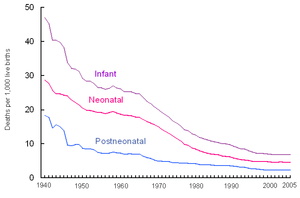Perinatal mortality
Perinatal mortality (PNM) refers to the death of a fetus or neonate and is the basis to calculate the perinatal mortality rate.[1] Variations in the precise definition of the perinatal mortality exist, specifically concerning the issue of inclusion or exclusion of early fetal and late neonatal fatalities. The World Health Organization defines perinatal mortality as the "number of stillbirths and deaths in the first week of life per 1,000 total births, the perinatal period commences at 28completed weeks (196 days) of gestation, and ends seven completed days after birth",[2] but other definitions have been used.[3]
| Perinatal mortality | |
|---|---|
| Other names | Perinatal death |
 | |
| Infant, neonatal, and postneonatal mortality rates: United States, 1940-2005 | |
| Specialty | Public health |
The UK figure is about 8 per 1,000 and varies markedly by social class with the highest rates seen in Asian women. Globally, an estimated 2.6 million neonates died in 2013 before the first month of age down from 4.5 million in 1990.[4]
Causes
Preterm birth is the most common cause of perinatal mortality, causing almost 30 percent of neonatal deaths.[5] Infant respiratory distress syndrome, in turn, is the leading cause of death in preterm infants, affecting about 1% of newborn infants.[6] Birth defects cause about 21 percent of neonatal death.[5]
Fetal mortality
Fetal mortality refers to stillbirths or fetal death.[7] It encompasses any death of a fetus after 20 weeks of gestation or 500 gm. In some definitions of the PNM early fetal mortality (week 20-27 gestation) is not included, and the PNM may only include late fetal death and neonatal death. Fetal death can also be divided into death prior to labor, antenatal (antepartum) death, and death during labor, intranatal (intrapartum) death.
Neonatal mortality
Neonatal mortality refers to death of a live-born baby within the first 28 days of life. Early neonatal mortality refers to the death of a live-born baby within the first seven days of life, while late neonatal mortality refers to death after 7 days until before 28 days. Some definitions of the PNM include only the early neonatal mortality. Neonatal mortality is affected by the quality of in-hospital care for the neonate. Neonatal mortality and postneonatal mortality (covering the remaining 11 months of the first year of life) are reflected in the Infant Mortality Rate.
Perinatal mortality rate
| Top ten countries with the highest perinatal mortality rates - 2012[8][9][10] | |||||
|---|---|---|---|---|---|
| Rank | Country | PNMR | Rank | Country | PNMR |
| 1 | 40.7 | 6 | 29.0 | ||
| 2 | 32.7 | 7 | 28.9 | ||
| 3 | 30.8 | 8 | 28.3 | ||
| 4 | 29.7 | 9 | 27.5 | ||
| 5 | 29.4 | 10 | 27.4 | ||
| As per 2014 "Save the Children" report for intrapartum stillbirths and neonatal deaths on first day of birth (per 1,000 total births) | |||||
The PNMR refers to the number of perinatal deaths per 1,000 total births. It is usually reported on an annual basis.[11] It is a major marker to assess the quality of health care delivery. Comparisons between different rates may be hampered by varying definitions, registration bias, and differences in the underlying risks of the populations.
PNMRs vary widely and may be below 10 for certain developed countries and more than 10 times higher in developing countries . The WHO has not published contemporary data.
See also
- Neonatal intensive care unit
- Maternal death
- Neonaticide
- Miscarriage
- Pregnancy and Infant Loss Remembrance Day
References
- "Perinatal mortality rate (PMR) — MEASURE Evaluation". www.cpc.unc.edu.
- "WHO - Maternal and perinatal health". www.who.int.
- Richardus JH, Graafmans WC, Verloove-Vanhorick SP, Mackenbach JP (January 1998). "The perinatal mortality rate as an indicator of quality of care in international comparisons". Medical Care. 36 (1): 54–66. doi:10.1097/00005650-199801000-00007. PMID 9431331.
- GBD 2013 Mortality and Causes of Death, Collaborators (17 December 2014). "Global, regional, and national age-sex specific all-cause and cause-specific mortality for 240 causes of death, 1990–2013: a systematic analysis for the Global Burden of Disease Study 2013". Lancet. 385 (9963): 117–71. doi:10.1016/S0140-6736(14)61682-2. PMC 4340604. PMID 25530442.
- March of Dimes --> Neonatal Death Retrieved on November 10, 2014
- Rodriguez RJ, Martin RJ, and Fanaroff, AA. Respiratory distress syndrome and its management. Fanaroff and Martin (eds.) Neonatal-perinatal medicine: Diseases of the fetus and infant; 7th ed. (2002):1001-1011. St. Louis: Mosby.
- "NVSS - Fetal Deaths". www.cdc.gov. 8 November 2017.
- "Reports and Publications" (PDF).
- "Million babies die a year - charity - IOL".
- "Nigeria, Pakistan, India lead the world in infant deaths - PM NEWS Nigeria". 25 February 2014.
- "Miscarriage Risk by Week and What Affects Your Risks of Miscarriage". 23 August 2015.
External links
| Classification |
|
|---|